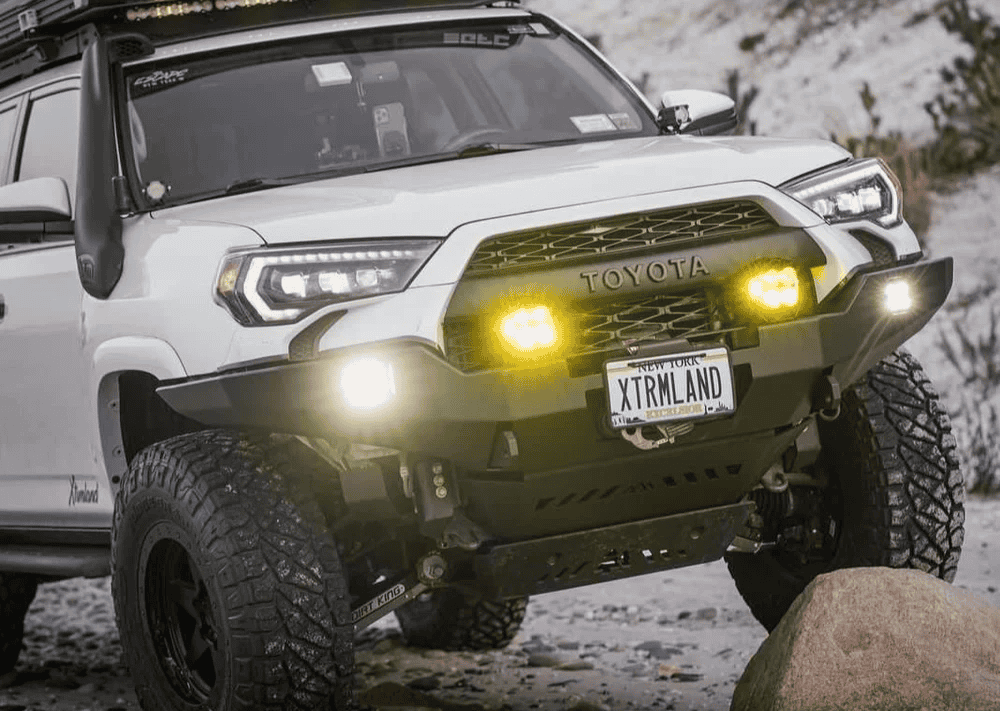Overland Vehicles

A custom rear bumper with tire carrier moves the spare out of the cargo area and onto a swing arm, freeing interior space while improving trail readiness. The bumper adds protection where scrapes and knocks are most likely and can improve departure angle by trimming bulky factory parts. A well designed carrier keeps a full size spare secure, prevents rattles, and swings clear for cargo access. Many setups integrate recovery points and a receiver so the bumper becomes a true utility system. The goal is simple: carry heavier gear safely while keeping the rig balanced, functional, and reliable on and off road.
Start with the structure. Look for boxed steel sections, properly gusseted corners, and welded recovery points tied into the frame. High clearance corners reduce hangups on ledges and ruts. A quality tire carrier uses a stout spindle with tapered roller bearings, a positive latch, and adjustable bump stops to tune the closing pressure. Add accessories that match your trips, such as jerry can mounts, a camp table, or an integrated step that supports real body weight.
Each platform needs specific solutions. Vans like Sprinter, Transit, and ProMaster have different rear door swings, sensor locations, and camera positions. Trucks vary in bed length, hitch height, and bumper contour. Confirm the carrier clears door glass, taillights, and rear wipers, and that it opens far enough to allow loading gear. If you tow, verify the receiver class, trailer plug relocation, and safety chain access. Plan for where the license plate and its light will live so everything stays legal and visible.
Material choice shapes performance and maintenance. Steel remains the standard for impact resistance and weld repair in the field. Aluminum trims weight and resists corrosion, but hinges and mounts often use steel inserts to handle the loads. Powder coat with a zinc rich base resists chips and rust; in salt country, add inner cavity sealers and carry touch up to stop nicks from spreading. Modularity matters too. A carrier that accepts bolt on plates for fuel, shovel, or a ladder lets you tailor the load for winter, long desert hauls, or a quick weekend trip.
The hinge is the heart. Large diameter spindles on tapered bearings carry the leverage from a heavy spare and gear. Some designs add a secondary safety pin, which is smart on washboard roads. Latches vary from cam and compression styles to rotary units with safety catches. Compression latches paired with urethane bump stops keep the swing arm preloaded so it does not chatter. Gas struts help control opening on a slope, but they should never be a substitute for a stout hinge.
A custom rear bumper with tire carrier adds weight behind the axle, so check rear spring capacity and shock tune if you run a large spare, fuel, and tools. Aim to keep heavy items close to centerline and low to reduce sway. Electrical work is part of a clean install. Relocate the license plate light, add an auxiliary plate light if needed, and route wiring in abrasion resistant loom with drip loops. Reverse sensors and cameras may need relocation brackets or reprogramming. In most states the plate must be clearly visible and lit, and brake and reverse lights cannot be obstructed.
Rigs that see gravel and mud benefit from regular rinse downs to remove abrasive grit from hinges and latches. Grease serviceable bearings at the intervals the builder recommends and inspect fasteners after the first few trail days, then seasonally. Tighten adjustable latches as the weather changes to maintain preload and silence. Keep a small kit with touch up paint, a spare latch pin, and a tube of thread locker in the cargo area so you can fix small issues at camp.
A thoughtful build pays off every mile. Tire size dictates leverage, so a 35 or 37 needs a stronger hinge and closer tire mount than a compact spare. Recovery points should be rated and welded through the bumper into the mounts, not just stitched to the skin. The receiver must be welded and braced to carry both a bike rack on the highway and a recovery step on a climb. Most of all, the carrier should open and close with one hand, stay quiet, and never distract you when you are driving a rough road.
When it is time to turn a plan into metal, choosing a shop that understands overland use is everything. Fabrication skill is only half the story; integrating sensors, lighting, and towing cleanly is where daily drivability is won or lost. If your vision includes a full rig strategy that blends bumper design with suspension, racks, and power systems, explore our Overland rigs. For tailored metalwork, accessory integration, and a precise fit, see our Custom overland upfit. Curious about process, communication, and handoff support at our Fayetteville Arkansas shop, read Why choose OZK Customs.
Share your tire size, recovery needs, and how you travel, and we will map a bumper that carries the load quietly and confidently. Whether you are building a long range van or a trail focused truck, our team can design, fabricate, coat, and install a custom rear bumper with tire carrier that suits your routes and your gear.
Ready to spec a bumper that fits your rig and your trips? Share a few details below. Our Fayetteville Arkansas team will price, design, and schedule your install.
ADDRESS:
6159 E Huntsville Rd, Fayetteville, AR 72701
PHONE:
(479) 326-9200
EMAIL:
info@ozkvans.com